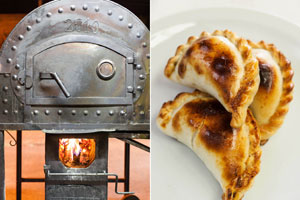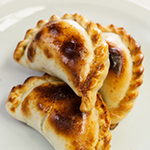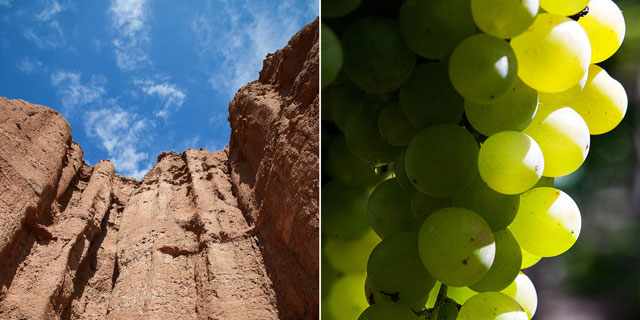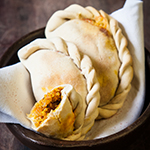The northeast of Argentina is a world unto its own. Crossing the mountains from the dense greenness of Tucuman, you quite suddenly find yourself in the empty, arid plains of Salta, filled only with jagged cliffs and creases in the dusty red rock and littered with Cardon cacti, tall but chubby like basketball players on a hot-dog diet.
They raise their plump limbs up, as if shielding the eyes from the none-too-kind Salta sun, or maybe, saluting a distant officer. Around here, they tell a story of a famous general, who, finding himself hopelessly outnumbered by the Spanish, dressed up hundreds of these cacti, spread his men among them and set them to making a racket. The Spanish, seeing this formidable if unruly bunch arrayed against them, turned and fled without firing a shot.
Salta is a good place for stories. Its snaky valleys, or quebradas as they are locally known, are full of the ghosts of ancient indigenous cultures; these days mostly evidenced by the odd arrowhead pottery shard or rock paintings.
The newest story in town is a biblical one, if you will, a good old story of water into wine. The Calchaqui Valleys cut through Salta and trickle into Catamarca in the north and Tucuman in the south. Near the middle, where the Calchaqui, Santa Maria, and Conchas river meet (each having gauged out some quite spectacular hiking valleys) the valleys flattens out and are filled with those distinctive rows of neatly controlled vines that makes any wine lover’s heart smile a little boozy smile.
All around the city of Cafayate and rising up against the sides of the valley a number of new and traditional wineries are making spectacular wines. The star here, of course, is Torrontes, but some great Malbec and Cabernet Sauvignon are also being made. For something different, try the Tannat made by Quara or Bodega El Porvenir.
All this wine makes any traveller hungry, and here in Cafayate hunger is something to delight in. Salta is known for food that is quite different from anywhere else in Argentina, mainly thanks to the influence of indigenous Andean and Incan cultures.
KNOW BEFORE YOU GO
What to Eat:
The classic dishes of the region, humitas are ground corn mixed up with some onion and spices, goat’s cheese, and sometimes, olives or chicken. This paste is wrapped in the leaf of the cob and steamed or boiled. It's my favorite thing to eat in this part of the world. Locro is a hearty Andean stew, ingredients vary, but it has a base of corn, meat and vegetables. Try them both at El Hornito (Rivadavia 300), very much a local’s spot, away from the main square.
 You also must try empanadas. They are everywhere and everybody has an opinion as to who makes the best (after their mama, of course). My favorites are from a little place in the Paseo del Artesano market just off the main square: diced beef, loads of juice, and a great pastry. (Kappa, San Martin 58, +54 3868 156 38498) The most popular spot is La Casa de Las Empanadas (Mitre 24, +54 3868 421589) with a huge menu of empanadas, plenty of other regional foods, and walls filled with messages from visitors. The service wasn’t shining on my visit, but so it goes. Equally as good, if less well known, is El Chueco across the road.
You also must try empanadas. They are everywhere and everybody has an opinion as to who makes the best (after their mama, of course). My favorites are from a little place in the Paseo del Artesano market just off the main square: diced beef, loads of juice, and a great pastry. (Kappa, San Martin 58, +54 3868 156 38498) The most popular spot is La Casa de Las Empanadas (Mitre 24, +54 3868 421589) with a huge menu of empanadas, plenty of other regional foods, and walls filled with messages from visitors. The service wasn’t shining on my visit, but so it goes. Equally as good, if less well known, is El Chueco across the road.
Finally, try baby goat, slow cooked for hours in the oven. Enough said really. At El Rancho on the main plaza (Vicario Toscano 4 +54 3868 42 1256) it is unbeatable. The meat falls off the bone and it is well spiced with local ground dried red peppers. All their local foods are excellent and this is easily the best option for a long dinner with access to a good wine list.
Finish off any meal with the now famous wine ice cream from Heladería Miranda (Av. Güemes Norte 170), it comes in both Torrontes and Cabernet flavor.
Insiders tip: On the road heading up to Finca Las Nubes, about 2 kilometeres before arriving, there is a little turn off to the right to a waterfall and some rock paintings. At the entrance you will find a little food stall and the nice lady there makes simply the best humita I have ever had! (Finca las Nubes is a great option for a snack overlooking the vineyards and with an amazing view. With previous reservation, they can also do a full asado for you, accompanied by the wines from the estate, by one of the region’s best winemakers, Jose Mounier.)
What to Drink:
Try Torrontes from: Bodegas Etchart, Gran Linaje Torrontes, a brilliant wine that has recently taken up my number one spot for Torrontes; Bodega El Porvenir, Laborum Torrontes, only just pipped by The Etchart wine; Finca las Nubes, Jose L Mounier Torrontes; and San Pedro de Yacochuya Torrontes. If you're looking for a great value, try: Domingo Hermanos, Reserva Torrontes, a nice winery to visit and even better, they have a nearby goat’s cheese farm also open to visits!
Can't wait to get there? Head into the kitchen and cook up some of these empanadas yourself.

- 5 ounces beef lard (suet)
- 2 large white onions, diced
- 2 tablespoons ground red pepper
- 2 tablespoons paprika
- 1 tablespoon ground cumin
- 2 pounds sirloin beef, cut into 1/4-inch cubes
- 2 large potatoes (1 pound) boiled to al dente, two tablespoons water reserved, and then peeled and diced to 1/4-inch cubes
- 4 spring onions finely chopped
- salt, to taste
- 4 hard boiled eggs, peeled and chopped
- 3/4 cup quinoa
- 1 large carrot, grated
- 1/2 cube chicken bouillon
- 1 pinch fine salt
- 1 tablespoon olive oil
- 1 large white onion, finely chopped
- 1 clove garlic, chopped
- 1 bay leaf
- 4 ounces goat cheese, cut into small cubes
- 3 ounces black olives, pitted and finely chopped



![Making Mealtime Matter with La Familia: Easy Sofrito [Video]](https://thelatinkitchen.com/wp-content/uploads/2015/10/sofrito-shutterstock__0-500x383.jpg)
![Easy Latin Smoothies: Goji Berry Smoothie [Video]](https://thelatinkitchen.com/wp-content/uploads/2015/12/goji_berry-shutterstock_-500x383.jpg)
















![Fun and Fast Recipes: Fiesta Cabbage Salad [Video]](https://thelatinkitchen.com/wp-content/uploads/2015/11/fiesta_cabbage_slaw-shutterstock_-500x383.jpg)









